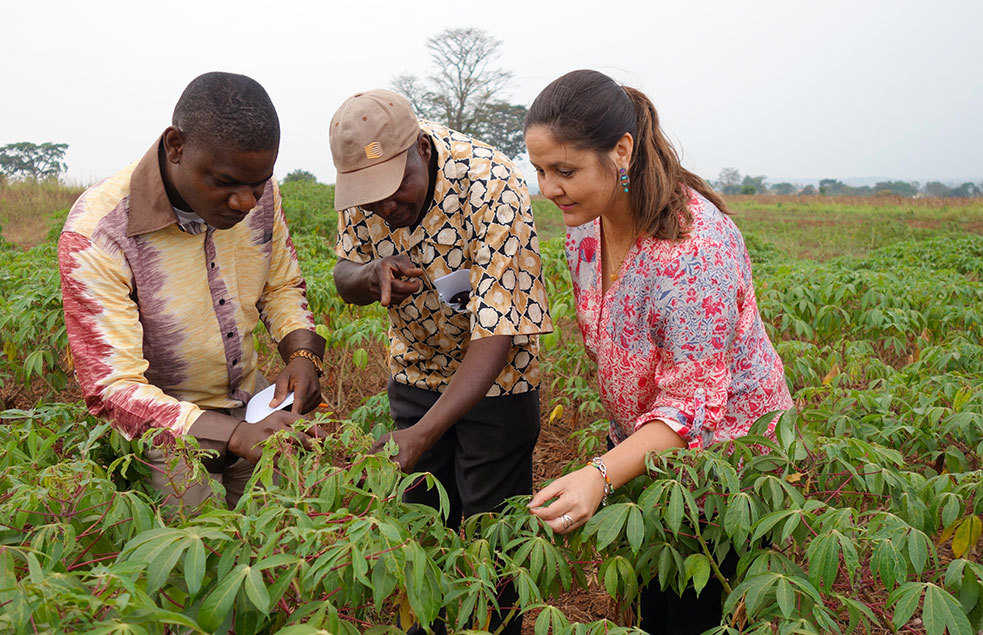
Laura Boykin, right, and fellow researcher Donald Kachigamba, at left, inspect African whiteflies feeding on cassava leaves at a farm near Namulonge, Uganda. While scientists once assumed there was only one species of whitefly worldwide, Boykin’s work has identified at least 34. Photo: Courtesy of Laura Boykin
For decades, the farmers of East Africa have battled the African whitefly, a tiny insect that infests the cassava crop. Cassava, also called manioc, arrowroot or tapioca, is an important food all over the world — more than half a billion people (yes, billion with a b) rely on cassava for their daily meals. For East African farmers, a whitefly infestation can completely destroy the year’s crop, and with it the food security for their families.
Yet surprisingly little is known about the whitefly itself. It’s only in the past few years, in fact, that scientists even knew whether there was more than one species — and now, it turns out, there are at least 34. Who’s counting? Computational biologist Laura Boykin, who studies the Bemisia tabaci whiteflies that plague East Africa, using genomics, supercomputing and evolutionary history. With the data she’s gathering, now publicly available via WhiteFlyBase , she hopes to help researchers breed new strains of cassava that resist the whitefly.
We asked Boykin to tell us more about her work, how she discovered this problem … and how she realized she had the right skills to help solve it.
Tell us about the whitefly and cassava. Why is this problem crucial to solve?
700 million people around the world depend on cassava for their daily calories. Without it, for many families, there’s no food and there’s no income. To understand the importance of cassava in a farmer’s life, read The Last Hunger Season, by Roger Thurow. Depending on the country, farmers typically have a one-acre plot, which might include beans and other crops. In Kenya, for example, they’ll grow maize and sweet potatoes, and cassava is a backup. It’s planted and takes a while to grow, so when all the other crops are gone, the family thinks, “Okay, the cassava will get us through the hunger season.” But if it’s rotten due to whitefly, there’s absolutely no food.
Whiteflies transmit two viruses that kill cassava: cassava mosaic disease and cassava brown streak disease. In tandem, these cause 100 percent loss of the crop. It’s a massive problem, especially in East Africa. I’m one of 15 principal investigators working on a new project whose mission is to give farmers a cassava plant that’s resistant to the viruses and the whiteflies. How do we get there? Whiteflies are a global problem, creating havoc on every continent. So first, it’s identifying what whiteflies and viruses are present in East Africa.
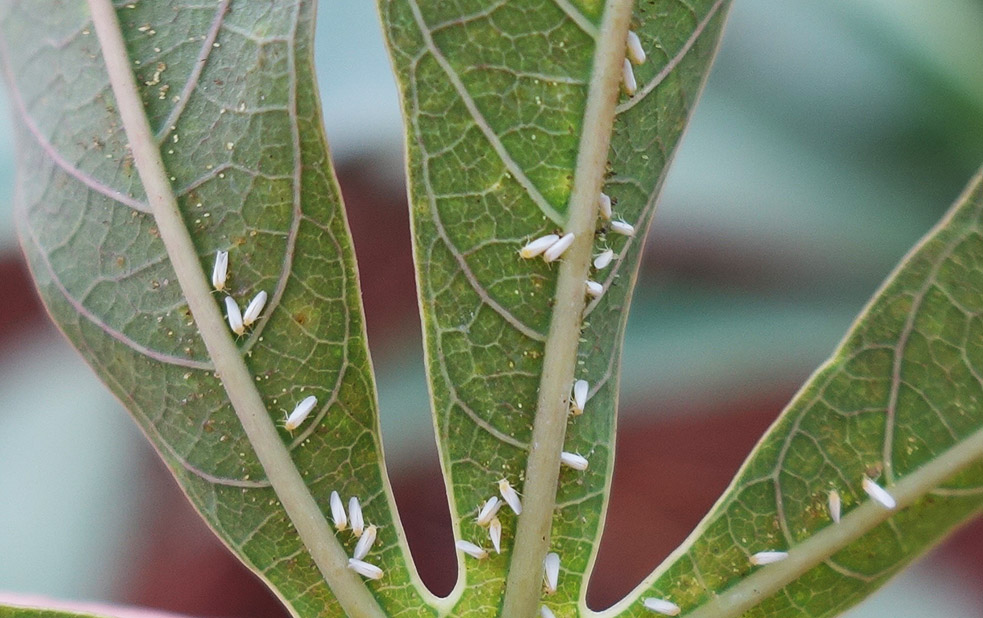
The African cassava whitefly feeds on the underside of cassava leaves. The viruses that these whiteflies transmit destroy cassava plants and render their roots inedible. Photo: Courtesy of Laura Boykin
Where did the problem originate?
Cassava originates from South America, and was taken to Africa in the 1700s. But these viruses aren’t found in South America. The hypothesis is that they’d been lying dormant in African native vegetation. We think that the whiteflies feed on native shrubs, then go feed on cassava, transmitting the virus from the shrubs to the cassava plants.
Fortunately, the viruses haven’t yet spread to West Africa, the biggest cassava-producing place in the world. Right now, the virus is concentrated in a pocket of East Africa: Tanzania, Uganda, Malawi, Mozambique and Zimbabwe. The hope is that we can control the whiteflies enough so that they don’t spread.
When did whitefly infestation start becoming a noticeable problem?
In the 1990s, researchers were attempting to control cassava mosaic disease that was breaking out in East Africa. They thought they had a control for it via traditional breeding. Then the cassava brown streak virus emerged; it turned out that whiteflies loved the new varieties that the researchers rolled out to control the first virus. In essence, the researchers had been trying to breed for virus resistance without taking into account that there might be different species of whiteflies.
We’ve done modeling based on genetic data indicating that Africa is the origin of the species, so it makes sense there will be the most diversity there. With that information, we are working to ensure that the people who are doing the plant breeding get the resistance right for all the whitefly species that the plant might encounter.
How did scientists not know that there was more than one species of whitefly?
This is the interesting part. The idea that there was only one species of whitefly worldwide was held for so long and became so ingrained that no one seems to care what the data says now. Meanwhile, the funding to do work on whiteflies — especially in sub-Saharan Africa — has been so scarce that no one was able to even look to see what’s there. It’s only been in the last seven years or so that people have started to do sampling of the region. The more we sample, the more we realize there are tons more species of whitefly in Africa than we ever thought.
One of the difficult things about identifying new species is that scientists are under pressure to not change their names, because then all the names within the governmental regulations have to be changed. There’s also pressure from chemical companies, who market their products for specific species. If we say there are 34 species — and not one — they have to test their products on all 34. We are creating more work for people, and there’s enormous resistance. But the science is the science. We need our solutions customized to the right enemy. It’s a non-negotiable point.
By the way, the whitefly is highly regulated around the world. Countries have massive regulations on whitefly moving across borders. It can transmit viruses to tomatoes, sweet potatoes and ornamental plants. They are dreaded worldwide.
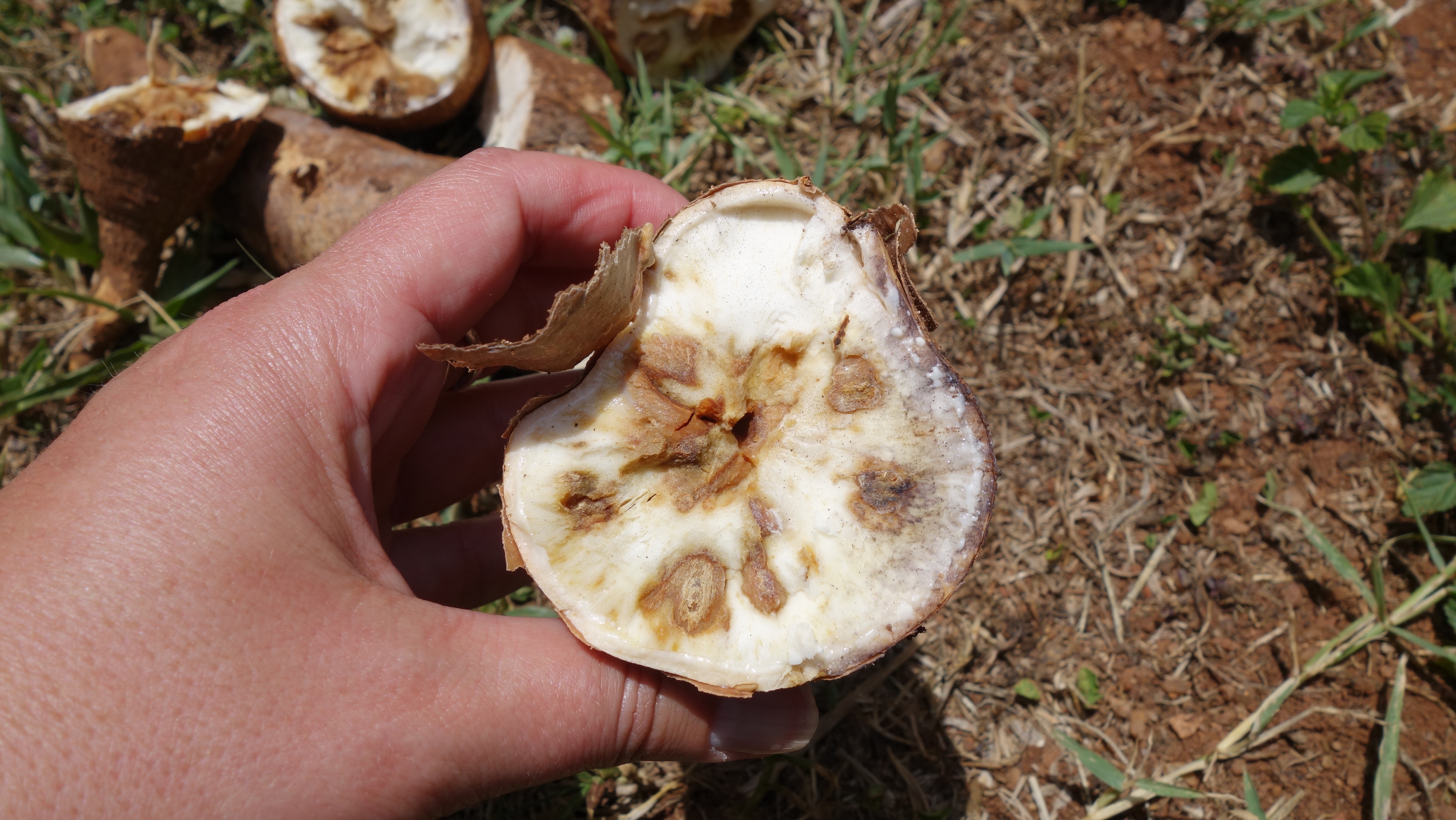
Cassava root infested with cassava brown streak virus, transmitted by the whitefly. A healthy cassava root has a center that is a solid, creamy white. Photo: Courtesy of Laura Boykin
Take us through your day. What do you do with whiteflies?
I have whiteflies in the lab, and we extract the DNA or the RNA. It sounds simple, but it’s probably three days’ worth of work. The majority of my time is then spent trying to deal with the data we generate from this material. We have these really cool sequencing machines, amazing HiSeq, MiSeq genomic-generating machines, in which we put the samples to generate their genome. The machine spits out a ton of data, and then we have the task of trying to make sense out of billions of base pairs — billions of As, Ts, Gs and Cs at a time. I work with a supercomputer called Magnus, which is the southern hemisphere’s fastest supercomputer. Who doesn’t love that?
I should note that the majority of the research is based in sub-Saharan Africa. We have partners at the Mikocheni Agricultural Research Institute in Tanzania, at the Department of Agricultural Research & Technical Services in Malawi, and at the National Crops Resources Research Institute in Uganda. Where I work at the University of Western Australia, we’re just contracted to do the things with equipment that’s not available in the region — basically, crunching numbers. A big part of what we do is also strengthening the skills of young African scientists. We have Ph.D.s who come for access to the genomic machines and the supercomputer. We’re in the genomic revolution. We have more genomic data than we know what to do with. So part of my goal is to train students on the skills to analyze all this data.
How did you become drawn to this subject — whitefly, cassava, small farmers, Africa?
I’m trained as a plant taxonomist, which is why I’m so into getting the species named correctly. But I realized at some point that I probably wouldn’t get a job doing that. Realistically, how many plant taxonomists actually have jobs at universities? Not many. So I thought if I learned how to analyze DNA data rather than focusing on the organism, I’d have a skill set I could apply to any problem.
I worked at Los Alamos National Laboratory for about four years. That was my first exposure to a supercomputer. I analyzed influenza and hepatitis C sequence data, to find clues to give the CDC about vaccines — on what strains could potentially be the next outbreak in the population. Those sorts of skills are invaluable for work with insects, because they invade the ecosystem like viruses invade our bodies.
I didn’t start working on invasive insects until a postdoc in Florida at the USDA. There, the whitefly problem lies with ornamental plant and tomato growers. Europe put an embargo on Florida flowers due to whitefly, and that was a big deal. So it wasn’t that I was particularly interested in insects. I just decided to put my skills to this problem, because in my opinion, fighting whiteflies is as important as vaccine selection. Farmers are struggling; let’s use what resources we have to get help.
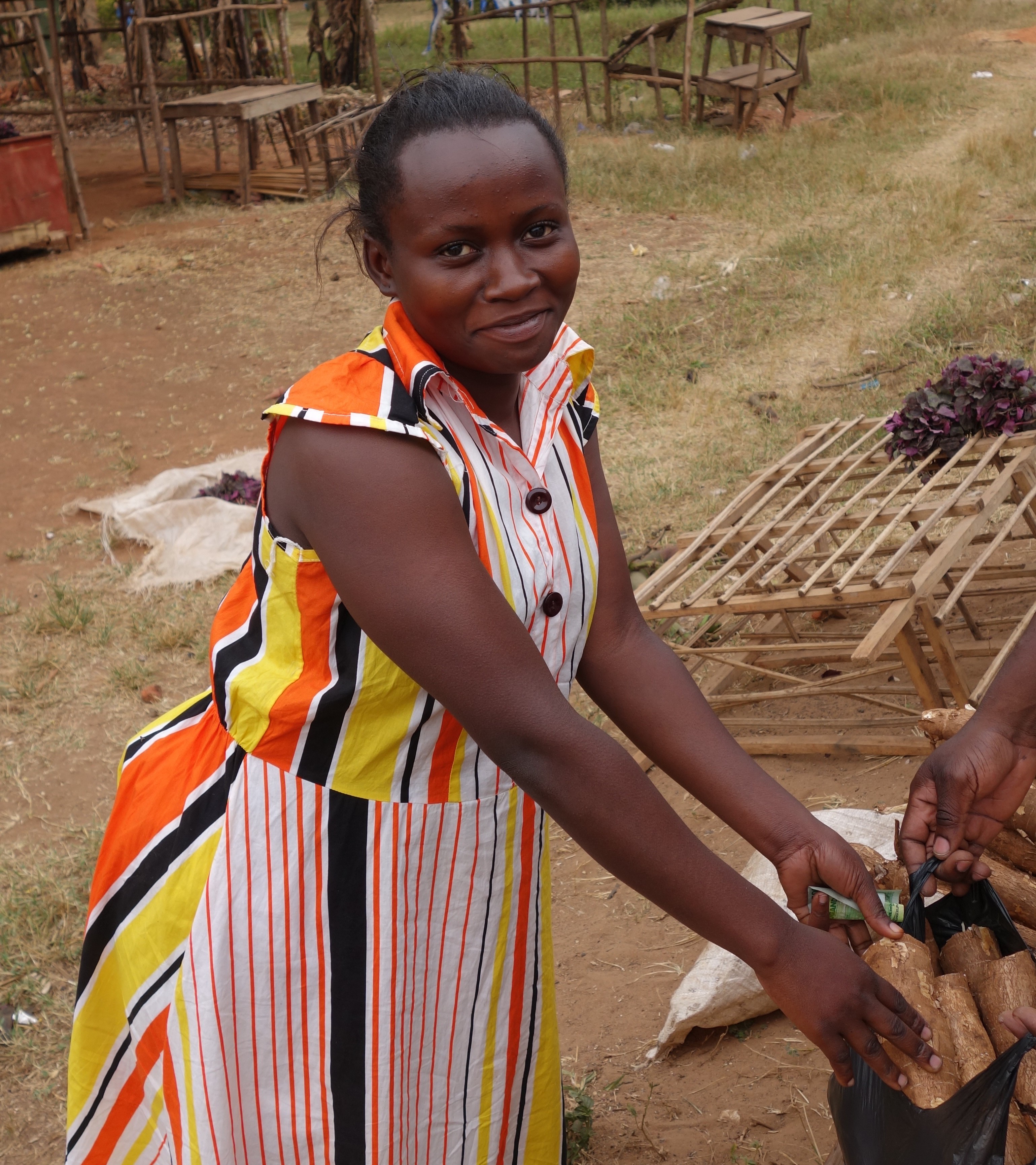
A farmer in Uganda shows what a healthy cassava looks like. The majority of small farmers in East Africa affected by cassava devastation are women. Photo: Courtesy of Laura Boykin
Why Africa?
I always took a global approach to figuring out how many whitefly species there were. I became interested in sub-Saharan Africa because, scientifically, it sits at the base of that [evolutionary] tree. The fact that they’ve been around for millions of years fascinated me.
In 2012, I attended an Agricultural Research Connections workshop hosted by the Bill and Melinda Gates Foundation in Kenya. During that trip, we visited a smallholder farm and I saw the devastation caused by whiteflies. At that moment, I was sold that this is what I needed to be doing. That was it. The situation was unacceptable, and my skills could be applied to the problem. I hadn’t considered before that I could pass them on to the next generation of scientists. I decided the best use of my time on Earth was to make a difference here.
So, when we were doing this big negotiation for our current funding, and it went through several rounds — if it didn’t come through, I was going to go home and live with my mother on the west side of Phoenix, Arizona. This work hits the absolute core of who I am.
Why does this work resonate so deeply with you?
My mom was a single mom — she had two kids and struggled to make ends meet. I thought to myself, these women — because the majority of these farmers are women — sacrifice everything for their kids. They are just like my mom. She sold hot dogs at Phoenix Suns basketball games to put me through college after her day job teaching school. In Africa, it’s like that, times a million. Women are the backbone of society.
These are the poorest people on the planet — how in the world can we not help? Why would I turn away from this? I wish that people who might not think they could help would consider the problem for just a split second. There are really smart people out there, and if everybody just gave a little bit of brain space, we could figure it out a lot quicker.
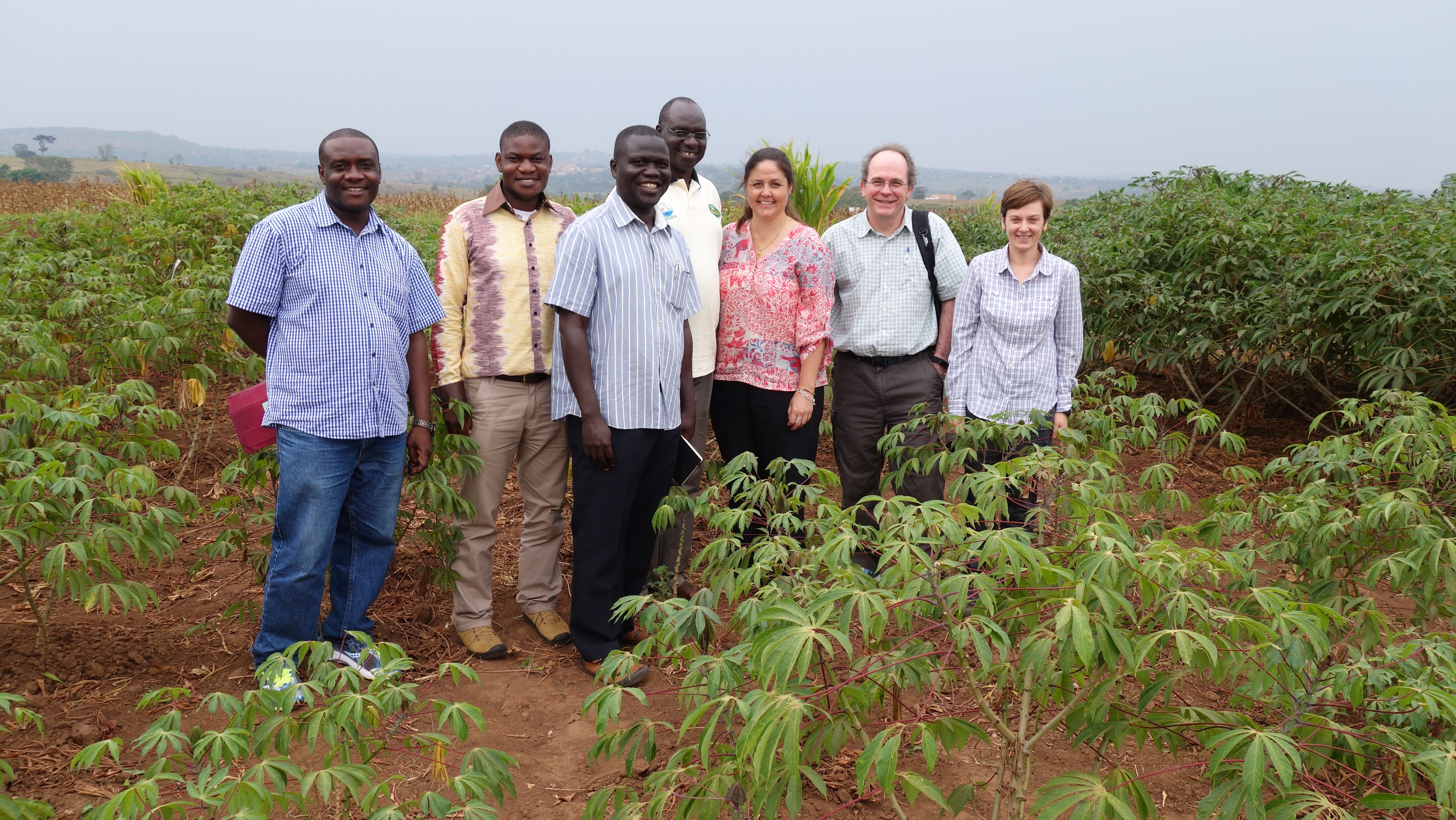
The collaborators on this project hail from around the world. From left to right: Peter Sseruwagi, Donald Kachigamba, Titus Alicai, Chris Omongo, Laura Boykin, John Colvin, Sarina Macfadyen. Photo: Courtesy of Laura Boykin
Wouldn’t it be wonderful if there were some sort of mechanism to get everybody who complained of being bored or underutilized at their job to drop everything and help with problems like this?
Exactly. I do think people want to work on real-world problems, if given the chance. For example, five computing students at UWA helped us make a database with all of our genetic information. They’re not biologists or agriculturalists, but when we made the opportunity available online, they stepped up, in spite of my colleagues’ skepticism that non-biologists would volunteer. They developed WhiteFlyBase, because they want their computational work to mean something. They had the skills, there was a problem, they contributed — done. The best news is they are now finalists for the Western Australian technology awards for their work.
Another example: recently, in Uganda, we interviewed Ph.D. students for a project. One application stood out to me — a mathematical modeler. I said to the team: “You guys, we need him.” They said, “He didn’t rank. He hasn’t got the agricultural skills.” But he turned out to be amazing, and he’s coming to the University of Western Australia to work with us. Having a diverse team is key to solving problems.
At the end of the day, the most magical part of this project are the people I have met in East Africa. The smallholder farmers, my friends and colleagues in Tanzania, Uganda, Kenya and Malawi make me want to keep doing science. For example, one of my collaborators, Dr. Joseph Ndunguru — who has singlehandedly has brought biotechnology to sub-Saharan Africa — is one of my idols in science. He’s so in love with trying to find solutions for smallholder farmers, it’s contagious.
There’s this drive, this work ethic. Nothing is too hard, because the problem is so big. There’s no complaining about trying to get papers into Nature or Science, or “impact factor.” My colleagues have got farmers coming to them who have nothing to eat — so it’s pretty straightforward. That’s what I call “impact”: science applied to people’s lives. All my days are now inspired by these farmers, and I will work as hard as I can.
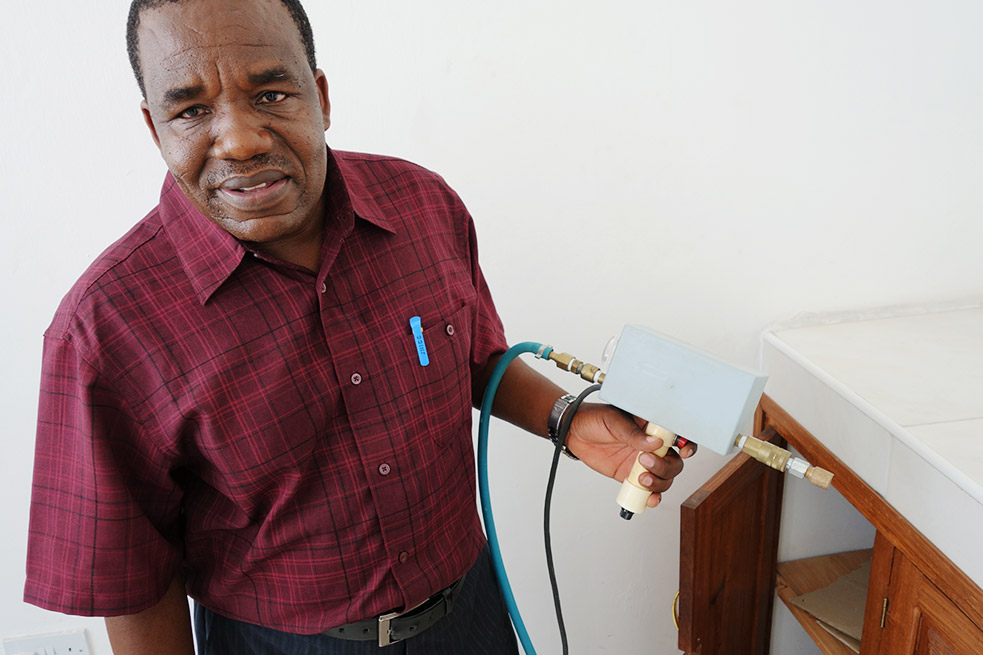
Joseph Ndunguru, head of the Mikocheni Agricultural Research Institute in Tanzania, holds a “gene gun” that can be used to inject cassava with resistant genes. Photo: Courtesy of Laura Boykin
Comments